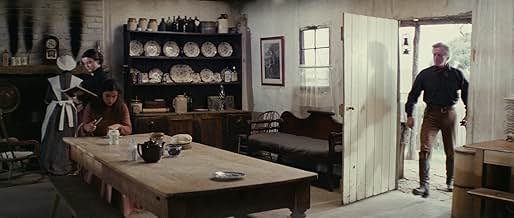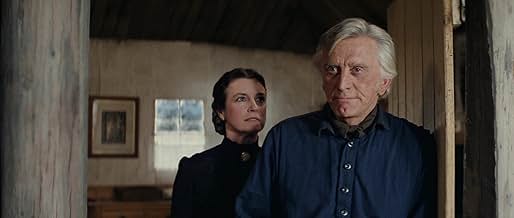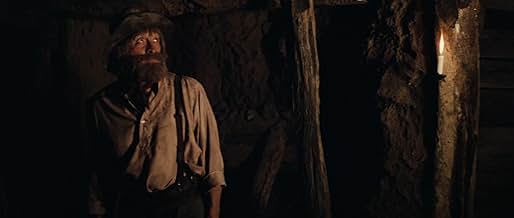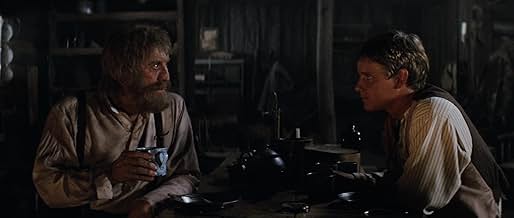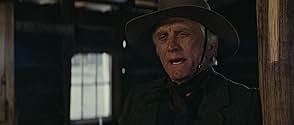NOTE IMDb
7,2/10
11 k
MA NOTE
Dans l'Australie des années 1880, après la mort du père du jeune Jim Craig, celui-ci accepte un emploi dans l'élevage de Harrison, où il est forcé de devenir un homme.Dans l'Australie des années 1880, après la mort du père du jeune Jim Craig, celui-ci accepte un emploi dans l'élevage de Harrison, où il est forcé de devenir un homme.Dans l'Australie des années 1880, après la mort du père du jeune Jim Craig, celui-ci accepte un emploi dans l'élevage de Harrison, où il est forcé de devenir un homme.
- Réalisation
- Scénario
- Casting principal
- Récompenses
- 2 victoires et 3 nominations au total
Avis à la une
This movie is both perfect and imperfect. Perfect because it has amazing horse riding scenes, beautiful cinematography and music, wonderful acting from Jack Thompson who captures the quintessential Clancy of the Overflow of Australian legend, and a great performance from Tom Burlinson, and showcases the skills of the 'real deal' cattlemen of the high country who acted as extras in the horse chase scenes, and finally because it can bring a tear to the eye the way Banjo Paterson's poem has for 120 years. This film was clearly a work of love and that is wonderfully conveyed.
However it's also imperfect because Kirk Douglas simply doesn't work in this context, and his two roles seem at times ridiculous. The storyline also meanders around at times, mostly in relation to one of Douglas's two characters, and it just seems a pity that an otherwise wonderful film has these flaws.
This is a movie to stir the heart, and well worth watching, and the horse chase scenes in the movie are now as much a part of Australia's culture as the original poem.
However it's also imperfect because Kirk Douglas simply doesn't work in this context, and his two roles seem at times ridiculous. The storyline also meanders around at times, mostly in relation to one of Douglas's two characters, and it just seems a pity that an otherwise wonderful film has these flaws.
This is a movie to stir the heart, and well worth watching, and the horse chase scenes in the movie are now as much a part of Australia's culture as the original poem.
THE MAN FROM SNOWY RIVER ***** An Australian western that centers its story on a coming-of-age mountain man (Tom Burlinson) who's father dies and must go to the lowlands to earn enough money to support the family farm. There, he finds work at a cattle ranch owned by Kirk Douglas, who wants to expand his success to something greater: unmined gold in the mountains. As Burlinson comes to grips with his new work setting and first love (Sigrid Thornton), he evolves into the man he needs to be to follow in his father's footsteps back home. It's excellent family entertainment, with a story that is basic enough for everyone to comprehend, yet doesn't hold a corny or simpleton status because of it. Be sure to rent it.
I must confess that I watched this film because I am a Kirk Douglas fan and I certainly was not disappointed in the dual performance he gives as two brothers, one an owner of the Australian equivalent of the Ponderosa and his hermit brother who lives up in the mountains among the wild horses and befriends young Tom Burlinson who becomes the man from Snowy River.
The film is a dramatization of a wild horse roundup such as you would have seen in the American West although American fans might be first thrown by use of the Aussie term 'brumbies'. What the origin of that idiom is I don't know, but for us Yanks just think 'mustang' and it will all become clear.
In fact I just finished a book on Australian general Sir Thomas Blamey and it is mentioned that during his boyhood in Wagga Wagga, he broke and rode 'brumbies.'
And of course the title and part of the plot is based on A.B. "Banjo" Patterson's poem. Patterson himself appears as a passing character in the film and presumably he was inspired by the incidents to write that poem.
Patterson for Australians is sort of a combination of Bret Harte and Mark Twain for Americans. That poem has a nice style and hopefully the poem The Man From Snowy River will be come as known in the western world at large as say Tennyson's Charge of the Light Brigade or Kipling's Gunga Din. In fact like in this film, Rudyard Kipling appears as a passing character in George Stevens's Gunga Din and fulfilled the same function there.
If the Australians felt they needed someone with the international star status of Kirk Douglas to open up the foreign market for this film, all well and good. I just hope Kirk's presence in the film did just that for this fine piece of entertainment.
And this review is dedicated to a couple Australian bull riders from the Professional Bull Riders whom I happened to meet, champions from the land down under, Jared Farley and Brendan Clark. No doubt descendants of the men who rode and broke those brumbies back in the day.
The film is a dramatization of a wild horse roundup such as you would have seen in the American West although American fans might be first thrown by use of the Aussie term 'brumbies'. What the origin of that idiom is I don't know, but for us Yanks just think 'mustang' and it will all become clear.
In fact I just finished a book on Australian general Sir Thomas Blamey and it is mentioned that during his boyhood in Wagga Wagga, he broke and rode 'brumbies.'
And of course the title and part of the plot is based on A.B. "Banjo" Patterson's poem. Patterson himself appears as a passing character in the film and presumably he was inspired by the incidents to write that poem.
Patterson for Australians is sort of a combination of Bret Harte and Mark Twain for Americans. That poem has a nice style and hopefully the poem The Man From Snowy River will be come as known in the western world at large as say Tennyson's Charge of the Light Brigade or Kipling's Gunga Din. In fact like in this film, Rudyard Kipling appears as a passing character in George Stevens's Gunga Din and fulfilled the same function there.
If the Australians felt they needed someone with the international star status of Kirk Douglas to open up the foreign market for this film, all well and good. I just hope Kirk's presence in the film did just that for this fine piece of entertainment.
And this review is dedicated to a couple Australian bull riders from the Professional Bull Riders whom I happened to meet, champions from the land down under, Jared Farley and Brendan Clark. No doubt descendants of the men who rode and broke those brumbies back in the day.
We often think of the Western as being a characteristically American film genre, although there have been occasional attempts to adapt its conventions to stories set in other parts of the world. "North-West Frontier", for example, is a British film set in British-ruled India, but the plot is essentially that of "Stagecoach". "Untamed" transfers the standard waggon-train plot from the American prairies to the South African veldt, and "The Sundowners", about Australian pioneer life, has similarities to many films set in the Old West. These two latter films, despite their ostensible setting, had an American leading man, Tyrone Power in "Untamed" and Robert Mitchum in "The Sundowners".
"The Man from Snowy River" is another Australian film with a plot which could be that of a Western. (One could call it a "Southern"). It also features a major American star, in this case Kirk Douglas, in a leading role. Or perhaps I should say that it features Kirk Douglas in two leading roles, the brothers Harrison, a wealthy cattle farmer, and Spur, a prospector. The action takes place in Victoria during the 1880s. Apart from the two brothers, the main character is Jim Craig, the "Man from Snowy River" himself. Jim is a young man orphaned by the death of his father in an accident, who goes to work on Harrison's station. The three main strands of the plot concern the relationship between the two brothers, who have been estranged for many years, the growing romance between Jim and Harrison's daughter Jessica, and the efforts to recapture a valuable stallion belonging to Harrison, which has escaped and is running with a herd of wild horses.
There are a number of differences in terminology; the wild horses are referred to as "brumbies" rather than "mustangs", Harrison's landholding is described as a "station" rather than a "ranch" and the reward for the recapture of the stallion is expressed in pounds rather than dollars. With those and a few other exceptions, however, the above synopsis could easily be that of a typical Western. And yet in some ways this is a very Australian film. The title and the story of the hunt for the escaped stallion derive from a narrative poem by the "bush poet" Banjo Paterson, although the other two strands of the plot are the inventions of the scriptwriters. Paterson himself appears as a character, as does Clancy of the Overflow, the hero of another of his poems. Paterson is something of a national icon in Australia, largely because his poetry helped to create the legend of the "Australian bushman", the tough, individualistic inhabitant of the Outback who plays a role in the Australian national imagination similar to that played by the cowboy in the American one. Clancy himself- a real individual, not a fictitious character- has come to be seen as the archetypal bushman.
"The Man from Snowy River" was made in 1982 during a decade when very few traditional Westerns were being made in America itself. (Perhaps the attraction of the film for Douglas was that it gave him a chance to star in one last "Western"). This was, however, a period when the Australian "New Wave" was starting to give that country its own cinematic identity with films about Australian history like "Picnic at Hanging Rock" and "Breaker Morant". This film, therefore, can be seen, not as an attempt to imitate Hollywood, but rather as an attempt to celebrate Australia's own history and culture in the way that the Western celebrated American history and culture. That other great celebration of the bushman, "Crocodile Dundee", a comedy with a contemporary setting, was to come shortly afterwards.
There are no really great acting performances, although Douglas copes well with the challenge of playing two very different characters, the autocratic, patrician Harrison and the more free-spirited Spur, even if his accent does not always hold up. The film is shot against some attractive mountain scenery, and the action sequences, especially the hunt for the missing stallion, are well done. This is a film which will appeal to anyone with an interest in Australia's past, as well to all horse-lovers. 7/10
"The Man from Snowy River" is another Australian film with a plot which could be that of a Western. (One could call it a "Southern"). It also features a major American star, in this case Kirk Douglas, in a leading role. Or perhaps I should say that it features Kirk Douglas in two leading roles, the brothers Harrison, a wealthy cattle farmer, and Spur, a prospector. The action takes place in Victoria during the 1880s. Apart from the two brothers, the main character is Jim Craig, the "Man from Snowy River" himself. Jim is a young man orphaned by the death of his father in an accident, who goes to work on Harrison's station. The three main strands of the plot concern the relationship between the two brothers, who have been estranged for many years, the growing romance between Jim and Harrison's daughter Jessica, and the efforts to recapture a valuable stallion belonging to Harrison, which has escaped and is running with a herd of wild horses.
There are a number of differences in terminology; the wild horses are referred to as "brumbies" rather than "mustangs", Harrison's landholding is described as a "station" rather than a "ranch" and the reward for the recapture of the stallion is expressed in pounds rather than dollars. With those and a few other exceptions, however, the above synopsis could easily be that of a typical Western. And yet in some ways this is a very Australian film. The title and the story of the hunt for the escaped stallion derive from a narrative poem by the "bush poet" Banjo Paterson, although the other two strands of the plot are the inventions of the scriptwriters. Paterson himself appears as a character, as does Clancy of the Overflow, the hero of another of his poems. Paterson is something of a national icon in Australia, largely because his poetry helped to create the legend of the "Australian bushman", the tough, individualistic inhabitant of the Outback who plays a role in the Australian national imagination similar to that played by the cowboy in the American one. Clancy himself- a real individual, not a fictitious character- has come to be seen as the archetypal bushman.
"The Man from Snowy River" was made in 1982 during a decade when very few traditional Westerns were being made in America itself. (Perhaps the attraction of the film for Douglas was that it gave him a chance to star in one last "Western"). This was, however, a period when the Australian "New Wave" was starting to give that country its own cinematic identity with films about Australian history like "Picnic at Hanging Rock" and "Breaker Morant". This film, therefore, can be seen, not as an attempt to imitate Hollywood, but rather as an attempt to celebrate Australia's own history and culture in the way that the Western celebrated American history and culture. That other great celebration of the bushman, "Crocodile Dundee", a comedy with a contemporary setting, was to come shortly afterwards.
There are no really great acting performances, although Douglas copes well with the challenge of playing two very different characters, the autocratic, patrician Harrison and the more free-spirited Spur, even if his accent does not always hold up. The film is shot against some attractive mountain scenery, and the action sequences, especially the hunt for the missing stallion, are well done. This is a film which will appeal to anyone with an interest in Australia's past, as well to all horse-lovers. 7/10
Disregard the goofs, inconsistencies and any other flaws that are mentioned in the reviews. This movie is beautifully photographed; in many cases, I don't know how. Great horse riding....again, I don't know how and the music raises goose bumps. This movie is any frustrated "cowboy's" dream. It is unbelievable that anyone can stay on a horse in a controlled ride during the scenes. I would love to read more technical details about the filming of this movie......especially how Kirk Douglas was able to fold his leg at the knee and put it all in one pant leg. The camera set ups and shots had to be pure genius to think they actually worked. It is very easy as I said before to overlook, even if you recognize them, any flaws.
Le saviez-vous
- AnecdotesTom Burlinson had never ridden horses much before making this movie and when he took Denny over the cliff to go after the brumbies that was a one-take shot at full gallop down the cliff face.
- GaffesAt the end of the film when the brumbies are being driven toward a holding corral, the mare Bess and the colt are way out in front. They're domesticated, and they'd know that the ranch meant food and water, so they'd be more eager to return than the others.
- Crédits fousA herd of wild horses stampede over the hills after the end credits.
- Versions alternativesNBC edited 8 minutes from this film for its 1987 network television premiere.
- ConnexionsEdited into Terror Nullius (2018)
Meilleurs choix
Connectez-vous pour évaluer et suivre la liste de favoris afin de recevoir des recommandations personnalisées
Détails
- Date de sortie
- Pays d’origine
- Langue
- Aussi connu sous le nom de
- Herencia de un valiente
- Lieux de tournage
- Sociétés de production
- Voir plus de crédits d'entreprise sur IMDbPro
Box-office
- Budget
- 3 500 000 $US (estimé)
- Montant brut aux États-Unis et au Canada
- 20 659 423 $US
- Week-end de sortie aux États-Unis et au Canada
- 694 126 $US
- 7 nov. 1982
- Montant brut mondial
- 20 708 426 $US
- Durée
- 1h 42min(102 min)
- Mixage
- Rapport de forme
- 2.35 : 1
Contribuer à cette page
Suggérer une modification ou ajouter du contenu manquant


